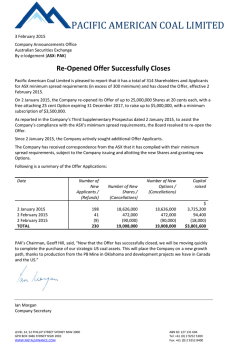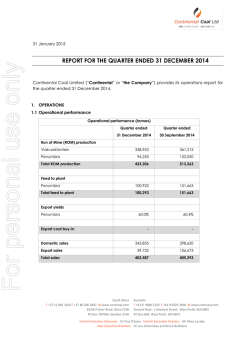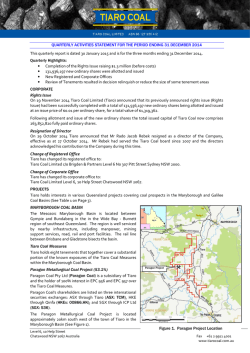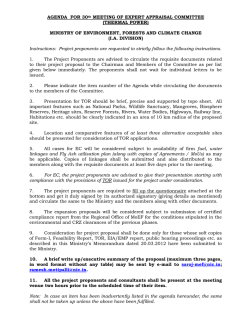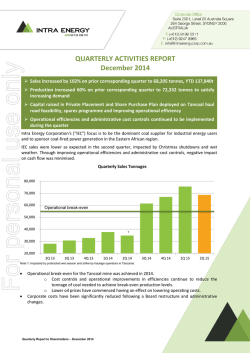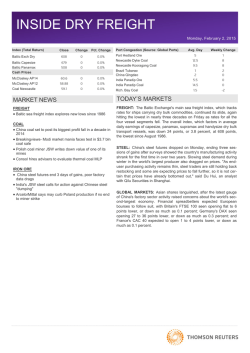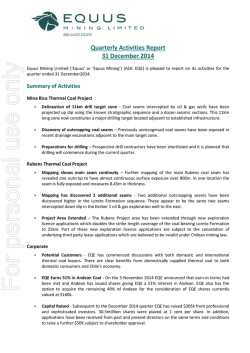
NATIONAL COAL COUNCIL ~ JANUARY 2015
NATIONAL COAL COUNCIL ~ JANUARY 2015 NCC SPRING MEETING SET JOIN US FOR CHERRY BLOSSOM SEASON APRIL 7-8 ~ GRAND HYATT The 2015 National Cherry Blossom Festival will begin the first day of spring, Friday, March 20th and continue through Sunday, April 12th. We hope you’ll plan to join us during this lovely time in Washington, DC for the National Coal Council’s Full Council Meeting. The NCC Spring 2015 Meeting will be hosted at the Grand Hyatt Washington, 1000 H Street, NW in Washington, DC. We’ll begin, as usual, with our Welcoming Reception on the evening of Tuesday, April 7th. The Full Council Meeting will be held the following day, Wednesday, April 8th, 9 am-12:30 pm. Additionally, the NCC Communications Committee will meet on April 7th. The Grand Hyatt is offering a very special rate of $209 for our group; this rate is valid three days prior to and after April 7th (subject to availability). We invite you to join us for the NCC meeting and spend some time enjoying Washington, DC at its finest. NCC LEADERSHIP Jeff Wallace, NCC Chair Vice President Fuel Procurement Southern Company Services Mike Durham, NCC Vice Chair President & CEO Advanced Emissions Solutions Fred Palmer, Coal Policy Chair Senior VP, Peabody Energy Bill Brownell, Esquire Vice Chair Coal Policy Chair, Hunton & Williams Executive Committee Joe Hopf Senior VP Fossil & Hydro PPL Energy Plus Clark Harrison, Sr. Mgr. Bus. Dev. CH2M Hill Chris Jenkins, VP Coal & Auto CSX Transportation Holly Krutka, Executive Editor Shenhua Science & Technology Research Institute John Long, COO, Connemara Ltd. Rich Lopriore, President PSEG Fossil LLC Mike Sorensen, Sr. Mgr. Fuel Tri-State G&T Kathy Walker, President Elm Street Resources Ex Officio Joe Craft, III, President Alliance Coal John Eaves, NCC Chair President & CEO, Arch Coal Mike Mueller VP Energy Mgt. & Trading Ameren Missouri Georgia Nelson, CEO PTI Resources LLC Finance CHAIR ~ Gregory Workman Director Fuels Dominion Resources We’re in the process of putting together a program on topics of interest to NCC members. Let us know if you have speaker or topic recommendations. Details regarding the program, meeting registration and hotel reservations will be emailed to NCC members by month-end January 2015. [Pick the date] [Edition 1, Volume 1] Robert Bibb, PE Bibb Engineers, Architects Paul Gatzemeier, CBCC Kathy Walton, Principal The Basic Industries Group NCC Staff Janet Gellici, EVP & COO Hiranthie Stanford Member & Meetings Manager Legal Counsel ~ Hunton & Williams NationalCoalCouncil.org 1101 Pennsylvania Ave. NW Ste. 600 Washington, DC 20004 (202) 756-4524 NATIONAL COAL ADVISORY NCC WEBCAST SCHEDULED JANUARY 29th TO REVIEW NCC STUDY Bridging the CCS Chasm: An Assessment of Opportunities to Advance CCS/CCUS Deployment The National Coal Council (NCC) will be hosting an official Full Council Meeting on Thursday, January 29th, 2015, 11 am-Noon Eastern via webcast for the purpose of reviewing the findings and recommendations of the NCC’s latest report for Energy Secretary Moniz entitled “Bridging the CCS Chasm.” NCC members will shortly be receiving an email from NCC staff with details on how to register for the meeting and instructions on how to join the WebEx webinar. WebEx requires a computer, web browser and an installed application (free). Information on the meeting was published in the Federal Register on January 7th in compliance with FACA regulations. IMPORTANT DATES January 14th, 2015 Coal Policy Committee January 29th, 2015 NCC Full Council Webcast Meeting 11 am-Noon Eastern In late Spring 2014, Secretary Moniz requested the NCC “conduct a study that assesses the value of DOE’s Carbon Sequestration Program … The assessment should answer the question – what is the industry’s assessment of the progress made by the DOE and others regarding cost, safety and techical operation of CCS/CCUS? … how does industry see and accept major technical findings from the CCS/CCUS community and how do these relate to DOE programs and investments …” The study is being chaired by Amy Ericson, U.S. Country President, ALSTOM; Technical Chair and principal author/editor is Carl Bozzuto (ALSTOM Power). Lead authors include Holly Krutka (Shenhua Group), Pam Tomski (Global CCS Institute), Shannon Angielski (CURC) and Jeff Phillips (EPRI). The study has undergone an extensive review by NCC members and stakeholders. A penultimate review will be undertaken by the NCC Coal Policy Committee (CPC) meeting on January 14th in Washington, DC. CPC comments will be incorporated into a final review document that will be sent to all NCC members in advance of the January 29th webcast. The report will also be posted on the NCC website at: http://www.nationalcoalcouncil.org/newsletter/Bridging_the_CCS_Chasm.p df NCC members are encouraged to participate in the January 29 th webcast which will feature a presentation by Ericson detailing the study findings and recommendations. During the webcast, NCC members will vote on whether to approve the study. As always, if you have questions, please contact Janet Gellici at [email protected]. 2 COAL RESOURCES Department of Energy www.doe.gov Office of Fossil Energy National Energy Technology Laboratory www.netl.doe.gov Coal & Power Systems EIA Coal Data Browser www.eia.gov/coal/data/b rowser ~~~~~~~~~~~~~~~~~~~~~~~~~~~~~~~ Does Clean Coal Technology Have a Future? Wall Street Journal 11-23-14 GA PSC’s Tim Echols: “One Expensive Energy Diet” PACE Blog 12-11-14 FERC Plans Technical Conferences on EPA’s Clean Power Plan Beginning Feb. 19th FERC News Release 12-9-14 What It Would Really Take to Reverse Climate Change Google’s Research on Why Renewables Won't Save Us Cheaper Oil Complicates War on Climate Change CNBC 1-11-15. Growing Cities Hold Key to Curbing Climate Change Scientific American 1-12-15 Coal Represents Just 1.25% of Fossil Fuel Subsidies International Monetary Fund Potential Economic Impacts of A Stricter Ozone Standard National Association of Manufacturers Gellici Speaking Engagements National Association of State Energy Officials Washington, DC – February 5 Global CCS Institute Washington, DC – February 5 American Coal Ash Association Savannah - February 10 Institute for Clean Air Companies Hilton Head – April 24 ASME Power Energy Conference San Diego -June 30 National Coal Council NationalCoalCouncil.org NATIONAL COAL ADVISORY NCC Member Focus In this new year of 2015, Norman Kettenbauer celebrates 10 years of service to the NCC. Norman has been an engaged participant in numerous NCC studies over the years and is an active member of the NCC’s Coal Policy Committee. Thank you for your many contributions to the NCC! Norman Kettenbauer is Vice President of Engineering & Contracting for Longview Power LLC. Norman is one of the key executives responsible for the execution and management of the Longview Power Plant Rehabilitation Project which includes the rehabilitation of the boiler and appurtenant systems. With respect to the boiler and appurtenant systems, Norman is responsible for directing engineering and design activities, solutions selection, evaluation and selection of contractors, contracting and scope negotiations, establishing and monitoring the project schedule and budget, monitoring procurement and fabrication QA and QC, interfacing with the plant staff, execution of the outage, development of acceptance criteria and performance testing and validating the rehabilitation and repairs. Whew! Busy busy guy! NORMAN KETTENBAUER VICE PRESIDENT ENGINEERING & CONTRACTING LONGVIEW POWER LLC Longview Power is a 700 megawatt (net) electrical power generating facility in Maidsville, West Virginia. At a cost of approximately $2.0 billion, Longview is the largest privately-funded project in state history. Longview Power was developed on the principle that abundant domestic energy reserves can be utilized in a safe, environmentally responsible manner. Numerous technological advances and process efficiencies have been incorporated, allowing Longview to produce cost-effective power while meeting rigorous environmental standards. In addition to clean power, jobs, and revenues, Longview provides substantial further benefits to local communities. Prior to joining Longview Power in December 2013, Norman served in numerous managerial positions at Babcock & Wilcox. He began his B&W career in 2000 as a Boiler Process Engineer, advancing to New Product Planning Manager for Advanced Technology and then on to Principal Engineer for Boiler Process Engineering. Norman also served as B&W’s Proposal Manager for the Fossil Power Division and ultimately as Manager of Strategy Development and M&A. Longview Power’s advanced supercritical pulverized coal (SCPC) boiler technology and optimized efficiency offers the best heat rate (8,728 Btu/kWh) of any coal plant in the PJM electric power market. The plant utilizes low NOx burners with overfire air and SCR for NOx control, hydrated lime injection for acid mist control, a fabric filter baghouse for PM control and a wet FGD system for SO2 removal. The combined systems will also provide substantial mercury control. While at B&W, Norman was responsible for representing that company in all aspects of project development, negotiations, contracting and management of project partners for FutureGen 2.0. Over a 10-year period before launching his B&W career, Norman successfully owned and operated numerous retail businesses. 3 Norman Kettenbauer Longview Power LLC 1375 Fort Martin Road Maidsville, WV 26541 304-599-0930 Ext. 3034 [email protected] www.genpower.net NATIONAL COAL ADVISORY WELCOME WHO KNEW?* CHAIR’S ADVISORY COUNCIL MEMBERS The National Coal Council would like to thank the following for joining the 2015 Chair’s Advisory Council, providing NCC with added expertise and financial support. Mike Durham INVESTING IN TOMORROW’S LEADERS TODAY NCC studies frequently address the need for workforce training to develop a pool of talent with the skills to manage and operate critical energy systems in the future. One industry-based program provides an opportunity for coal businesses to advance and vest executive talent in the coal industry. TOMORROW’S LEADERSHIP COUNCIL George Duggan George McClellan Greg Workman ~~~~~~~~~~~~~~~~~~~~~~~~~~~~~~~ SUPPORT THE NCC JOIN THE CAC IN 2015 The Chair’s Advisory Council (CAC), organized through NCC, Inc., is comprised of knowledgeable, committed individuals who serve in an advisory capacity to the Council. The NCC leadership relies on CAC members for guidance and insights into opportunities for NCC to strengthen its programs, improve its management and evaluate its mission and services. CAC members are consulted individually throughout the year and invited to participate in Strategy and Executive Roundtable Sessions ~ small-group discussions with key energy industry stakeholders. CAC members receive special recognition at NCC events and in NCC communications (newsletter/website). Launched in 2009, the ACC’s Tomorrow’s Leadership Council (TLC) provides a meaningful opportunity for up-and-coming executives to enhance their industry knowledge and networks through projects and activities that advance industry-wide objectives as well as professional development goals. To-date, the TLC program has “graduated” over 100 executives from companies that include coal suppliers, utilities, railroads, engineering groups, terminals, law firms and service organizations. During the course of their year-long program, TLC participants are provided with opportunity to attend conferences and dinners with senior industry executives and to attend professional development seminars that advance their competence in project management, communications, research, networking and presentation skills. Working virtually with their TLC peers, participants undertake an annual project that provides informational benefits to industry. Past projects have included Coal Fundamentals (a tutorial on the coal industry), Coal Unplugged (nonpower generation uses of coal), Making Social Media Work for the Coal Industry and Coal Industry Advocacy. Beginning in 2015, the program is now open to ACC member companies AND non-member coalfocused companies and organizations. Registration for the 2015 TLC program is now open. For further information ~ http://www.americancoalcouncil.org/?tlc#jointlc If you are interested in joining the NCC Chair’s Advisory Committee in 2015, please contact Janet Gellici at [email protected]. *A regularly featured column on industry, university and government initiatives in support of clean coal technology development & commercialization. 4 NATIONAL COAL ADVISORY Review of Past NCC Reports on CCS/CCUS Highlight Consistent Recommendations Later this month, National Coal Council members will have the opportunity to review and consider approving the latest NCC study for Secretary Moniz. The study is entitled “Bridging the CCS Chasm: An Assessment of Opportunities to Advance CCS/CCUS Deployment.” In response to the Secretary’s request, it provides “industry’s assessment of the progress made by the DOE and others regarding cost, safety and techical operation of CCS/CCU.” As part of the study process, we reviewed the body of work on carbon management issues that the NCC has prepared for DOE since the year 2000, including: Research & Development Needs for the Sequestration of Carbon Dioxide ~ May 2000 Coal-Related Greenhouse Gas Management Issues ~ May 2003 Coal: America’s Energy Future (Volumes I & II) ~ March 2006 Technologies to Reduce or Capture & Store Carbon Dioxide Emissions ~ June 2007 The Urgency of Sustainable Coal ~ May 2008 Low Carbon Coal: Meeting U.S. Energy, Employment & Carbon Dioxide Emission Goals with 21st Century Technologies ~ December 2009 Expediting CCS Development: Challenges and Opportunities ~ March 2011 Harnessing Coal’s Carbon Content to Advance the Economy, Environment & Energy Security (CCS-EOR) ~ June 2012 Spanning more than a decade, these studies document a consistent set of findings and recommendations to the U.S. Department of Energy on policies and technologies NCC members advocate as a means to advance the deployment of carbon capture, storage and utilization technologies (CCS/CCUS). The NCC has consistently noted the following: Enhancing the efficiency of the existing coal generation fleet is a first step toward reducing CO2 emissions. New Source Review (NSR) disincentivizes power plant operators from pursuing efficiency improvements. Research and development (R&D) must be pursued simultaneously on numerous greenhouse (GHG) technologies with the aim of developing a portfolio of options suitable for various applications. Various CO2 storage options need to be identified and characterized. Monitoring and verification methods for CO2 storage need to re refined. Employ DOE-industry partnerships to demonstrate technologies on a large-scale basis with the aim of reducing technology costs and expediting commercial availability. International partnerships are necessary to advance GHG technology solutions and global adoption. Technology demonstration projects are critical for the advancement of CCS/CCUS technologies. Financial incentives and federal funding support are vital, especially for early mover and firstof-a-kind (FOAK) projects. Deployment of CCS/CCUS technologies offers the most impactful opportunity to achieve CO2 emissions reductions. 5 NATIONAL COAL ADVISORY Coal Currents Todd H. Cunningham, Contributing Editor A brief survey of leading coal industry stories of the past month. Highlighted underlined text links to the cited articles. Right click on highlighted text and select the “Open Hyperlink” option to view the cited article. CLIMATE CHANGE Negotiators Achieve "Breakthrough" in Global Climate Talks Meeting in Lima, Peru, officials from almost 200 nations agreed to reduce their fossil fuel emissions as part of the global effort against climate change. The New York Times described the agreement as a "breakthrough"; under the accord, every nation pledged to prepare a plan by March 31 to reduce such emissions at home after 2020; however, The Times noted, compliance will be motivated by peer pressure rather than by sanctions or other legal consequences. While helping secure approval of the deal, the publication said, this "name and shame" approach provides no deterrent other than international condemnation for submittal of a weak plan, or even no plan at all. Rather, it said, the motivations of world leaders and whether they care about other countries' views "are essential to success." This could also apply to the U.S., the newspaper pointed out: laws and regulations enacted after President Obama leaves office must be put into place for the U.S. to meet his pledge of emissions cuts of as much as 28% by 2025, and most Republican presidential contenders "have come out fiercely against" his climate policies. White House Directs Agencies to Consider Projects' Climate Effects The White House has released draft plans directing federal agencies to evaluate how certain projects and policies – in energy and mining, among other areas - will affect climate change before granting approval. According to National Journal Energy Edge, the initiative from the Council on Environmental Quality (CEQ) is aimed at agencies reviewing projects under the National Environmental Policy Act (NEPA), instructing them to "consider the extent to which a proposed action and its reasonable alternatives contribute to climate change through [greenhouse-gas] emissions and take into account the ways in which a changing climate over the life of the proposed project may alter the overall environmental implications of such actions." Energy Edge termed the guidance part of a wider Administration effort to bring a climate focus to federal agencies' decision making. While the White House said it was not creating new regulatory barriers for projects, the publication reported, the new plan is likely to draw pushback from business and industry groups that opposed a similar draft in 2010. ON CAPITOL HILL Industry at Center of Several Major Policy Questions in 2015 The Inside-the-Beltway publication Politico Morning Energy posed a set of policy questions that will drive the energy agenda in the coming year, including three hot-button issues for the coal industry: the year-end UN global climate change negotiations in Paris, EPA's greenhouse gas (GHG) emissions regulations, and the disposition of EPA's Mercury and Air Toxics Standard (MATS) rule in the U.S. Supreme Court. In its brief discussion of prospects for Paris, Morning Energy said there are still significant steps to be taken, including structural questions, legal issues, and which nations will pay to help developing nations adapt. An early test of the Administration's relations with Congressional Republicans on the issue will come with its request for $3 billion for the UN's Green Climate Fund, Politico said. On EPA's climate regulations, the publication pointed out that "the GOP Congress will take what steps it can to attack the rules through appropriations and other avenues, though how much lawmakers can actually do at this stage is limited." Finally, looking to the Supreme Court, the publication noted that the justices will take up the matter of when EPA should have considered the cost of complying with the regulation. "EPA remains confident it can defend the rule," Morning Energy specified. 6 NATIONAL COAL ADVISORY Coal Currents (continued) ENVIRONMENTAL REGULATION EPA Delays Release of Greenhouse Emissions Rules Until Summer The Administration has delayed release of the Environmental Protection Agency's (EPA) wideranging final rules governing carbon dioxide (CO2) emissions from power plants, present and planned, until mid-summer. The Agency did not provide a specific date. The Carbon Pollution Standards rule, applicable to future power plants, had been due by January 8 and the rule for existing power plants, the Clean Power Plan, was due by June 1. Announcing the delay in a conference call with reporters, Janet McCabe, EPA Acting Assistant Administrator, Office of Air and Radiation, reported that the proposed rules had garnered more than 4 million public comments, saying, "We'll work through those," ECT.coop reported. According to Politico Morning Energy, McCabe indicated that EPA also will launch a new rule making process to develop a model GHG reduction plan for existing power plants. States will be able to use the plan for guidance when writing their own rules, she said, and EPA would implement it itself if a state did not submit its own plan. High Court Win on Mercury Rule Challenge Could Vex Industry If the coal industry's challenge to EPA's Mercury and Air Toxics Standard (MATS) rule, slated for review by the U.S. Supreme Court, is successful, it could have an unintended consequence, E&E News reported: undermining the industry's primary legal challenge to the agency's GHG limits for power plants. The MATS rule, intended to limit emissions of mercury and other pollutants from coal-fired power plants and other facilities, was promulgated under authority of Section 112 of the Clean Air Act (CAA), the publication said. Meanwhile, the industry's primary challenge to EPA's GHG emissions rule, promulgated under authority of Section 111(d), is that the CAA prohibits regulation under that section because the agency is already regulating coal-fired plants under Section 112. But if the Supreme Court sides with the coal companies and throws out the mercury rule, E&E News quoted an environmental attorney as saying, "It would defeat that as a basis for a challenge right now." However, the publication noted, there are many ways the high court could rule in the mercury case. EPA Announces First-Ever Standards on Coal Ash Management EPA has announced first-time federal standards for coal ash management, regulating the arsenicand lead-containing material under the Resource Conservation and Recovery Act's (RCRA) Subtitle D nonhazardous waste provisions. According to Bloomberg BNA, the final rule requires closure of surface impoundments and landfills for combustion residue that doesn't meet engineering and structural standards. It also limits where new structures can be sited and calls for cleanup and closure of unlined impoundments. EPA said the regulation will set minimum federal standards, while leaving enforcement to the states. Bloomberg BNA noted that the rule "falls far short of the regulation envisioned by environmental advocates," which had urged regulation of coal ash under RCRA's Subtitle C hazardous waste provisions. The regulation will go into effect six months after publication in the Federal Register, it said; meanwhile, Congress is expected to tackle coal ash legislation this year and "significant legal battles over the regulation" are anticipated. The Washington Post reported that power plants produce about 140 million tons of the material annually, which had been exempted from federal regulation by Congress in the 1970s. INTERNATIONAL INTEREST U.S. Coal Exporters Affected by Drop in Chinese Imports Falling Chinese demand for thermal coal will probably have the largest impact on U.S. producers that sell into markets across the Atlantic Ocean, the global research firm Wood Mackenzie has reported. According to Platt's, this is because an estimated 25 mt drop in imports, ordered by China's government, from 2014 to 2015 "will push lower cost Indonesian and Australian thermal coal into the Atlantic." The publication quoted a Wood Mackenzie senior analyst as saying that South Africa, which can sell to either the Pacific Basin or the Atlantic Basin, is now shifting back to the Atlantic. Russian coal, cheaper following the drop in that nation's currency, also is outselling U.S. thermal coal in the Atlantic, he said. However, Platts noted, Powder River Basin (PRB) producers are less likely to be affected than their Appalachian and Illinois Basin counterparts. "The PRB is generally less exposed because it's a different type of coal," the publication quoted Wood Mackenzie's Jonny Sultoon as saying. With its low-sulfur and ash content, he added, PRB coal is well-positioned to meet a number of market needs throughout Asia. 7 NATIONAL COAL ADVISORY Coal Currents (continued) MINING AND TRANSPORTATION U.S. Coal Miners' Deaths Fell to All-Time Low Last Year, MSHA Says Interior Dept. Proposes Changes in Assessing Value of Coal Sixteen (16) coal miners died in work-related accidents in 2014, the lowest annual number ever recorded in the United States, the Mine Safety and Health Administration (MSHA) reported. The number of deaths in 2014 was about half what the industry experienced in the early 2000’s, when the number of working coal miners was at comparable levels, MSHA specified. According to AP, federal mine safety officials credit efforts such as more aggressive use of team inspections at problem sites and other measures, which they say has fostered more responsible behavior. "I do think we're seeing a cultural change in the mining industry that's for the better," MSHA chief Joseph Main told the news service. The Labor Department unit acknowledged, however, that there is a need to do more: mine operators must maintain effective safety and health management programs that are constantly evaluated, continue find-and-fix programs to identify and eliminate mine hazards, and provide training for all mining personnel. "It takes the entire mining community to continue to reach new milestones in health and safety," the organization underscored. The Interior Department has proposed changes for assessing the value of federal coal, oil and gas resources, as well as expanded Bureau of Land Management (BLM) guidance regarding the production of coal on public lands. The Department noted that current valuation regulations, dating from the late 1980s, have not kept pace with changes in domestic markets. “The initial steps we are taking are part of the larger effort to strengthen the management of coal production on public lands by providing greater certainty and predictability to the industry and helping to protect American taxpayers,” commented Deputy Interior Secretary Mike Connor. According to AP, the Department's announcement followed a recent surge in coal exports as industry sought alternatives to a weak domestic market. Critics claim that under rules set in the 1980s, companies could sell the fuel to affiliates and pay royalties on that price, then sell the coal for more overseas, potentially costing the government millions of dollars. Under the proposed changes, royalty payments would be based on a coal shipment's final point of sale. BY THE NUMBERS IEA: Global Demand for Coal Will Grow, But at Slower Rate The global demand for coal will continue to grow during the next five years, surpassing the 9-billion tonne level by 2019, the International Energy Agency (IEA) has reported. According to PennEnergy, the group's Medium-Term Coal Market Report noted that China will account for three-fifths of demand growth during this period, despite efforts to moderate its coal consumption. India, ASEAN countries and other nations in Asia will join China as the main engines of coal consumption growth, IEA said, offsetting declines in Europe and the United States. However, despite coal's contribution to energy security and access to energy, said IEA Executive Director Maria van der Hoeven, "coal use in its current form is simply unsustainable." Therefore, she said, "We need to accelerate deployment of carbon capture and sequestration." PennEnergy reported that the trend of slowing global growth in coal demand has continued, with an average annual rise of 2.1% forecast through 2019. This compares to the 2013 report's forecast of 2.3% for the five years through 2018 and the actual growth rate of 3.3% per year between 2010 and 2013, IEA said. Todd H. Cunningham, who writes the "Coal Currents" column for the Council's monthly National Coal Advisory, is available for additional writing projects involving coal and other energy policy issues. For information on Todd's background and experience, see his LinkedIn profile at www.linkedin.com. To discuss your editorial needs, contact Todd via email at [email protected]. 8
© Copyright 2025
